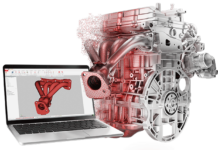
As part of their “Looking Ahead” series on megatrends influencing manufacturing, Sandvik Coromant launched a Graphene Challenge in 2015. The competition was a way for Sandvik Coromant to inspire the next generation of engineers by encouraging them to explore these new industry trends through their imagination and creativity. The winner, Nadia Ayad from Rio de Janeiro, Brazil, submitted the idea of using graphene for a filtration device and system for desalinization that would provide drinkable water to households. Her idea would significantly reduce energy costs and strain on current water supplies by recycling water.
As part of her prize, Nadia, a bachelor student in materials engineering at the Military Institute of Engineering (Instituto Militar de Engenharia – IME) was invited to Sandvik Coromant’s headquarters in Sandviken, Sweden to meet with industry professionals and visit the Graphene Centre at Chalmers University.
Nadia was chosen from ten top finalists by a distinguished panel of judges including David Goulbourne, Product Unit Manager at Sandvik Coromant; Marco Zwinkels, R&D Director, Technology Platforms at Sandvik Coromant; and Patrik Carlsson, Director for the Graphene Centre at Chalmers University. The top ten submissions were evaluated based on innovation, feasibility and design.
“We are very pleased with the quality of submissions we received from all over the world so it was not easy to select just one winner,” said David Goulbourne, Senior Product Unit Manager at Sandvik Coromant. “We were very impressed by how well researched Nadia’s submission was and how well she was able to conceptualize her idea.”
“Graphene is a material with high potential for innovation in many areas,” said Patrik Carlsson, Director for the Graphene Centre at Chalmers University. “The Graphene Challenge and the very interesting and wide ranging set of proposals we reviewed is a manifestation of this potential. It is also clear that graphene has the potential for disruptive technologies and innovations that do not fit within the present business models of existing companies. The Challenge was a good way to think outside of these business models.”
Q: How did you feel when you found out that you won The Graphene Challenge?
A: I felt very excited and surprised to be the winner. It was completely unexpected and that made me even happier.
Q: How did you hear about The Graphene Challenge?
A: I first heard about it online through my university.
Q: What made you decide to enter The Graphene Challenge competition?
A: Graphene is one of the most exciting materials right now; so I took this opportunity to learn more about it and challenge myself and see how far I could take my idea.
Q: How did you come up with your idea for the filtration device and system for desalinization?
A: With increasing urbanization, globalization, and the threat of climate change, it is projected that almost half of the world will live in water-stressed areas, so there is a real need for efficient methods of water treatment and desalinization. I thought that the unique nature of graphene and its properties, including its potential as a desalinization membrane and its superior sieving properties, could be part of the solution.
Q: What inspired you to pursue a career in engineering?
A: I was always fascinated with regenerative medicine and how we could use advanced materials to fix and improve the human body. This led me to pursue a career in materials engineering with a particular focus on research work in biomaterials and tissue engineering.


















